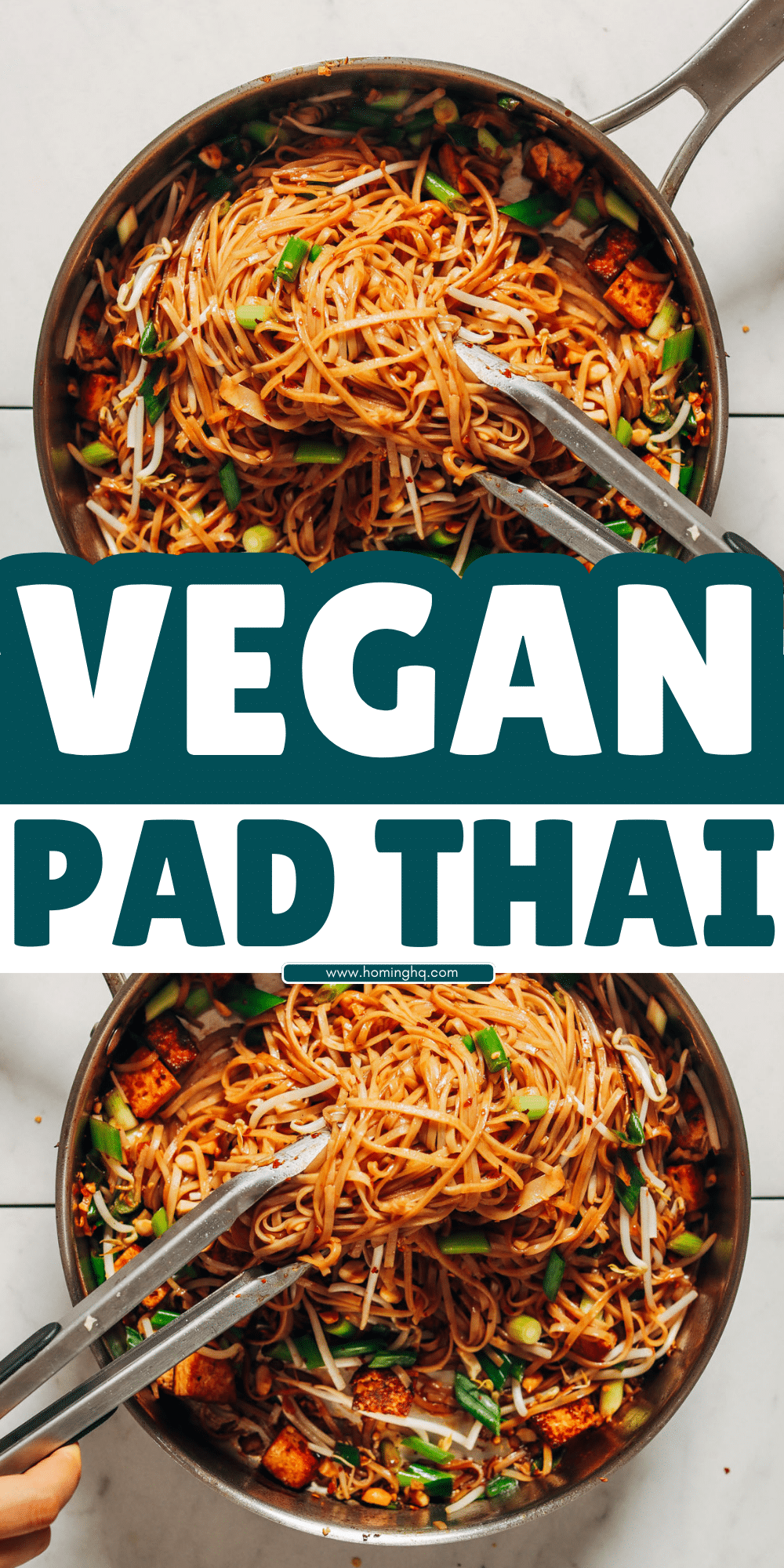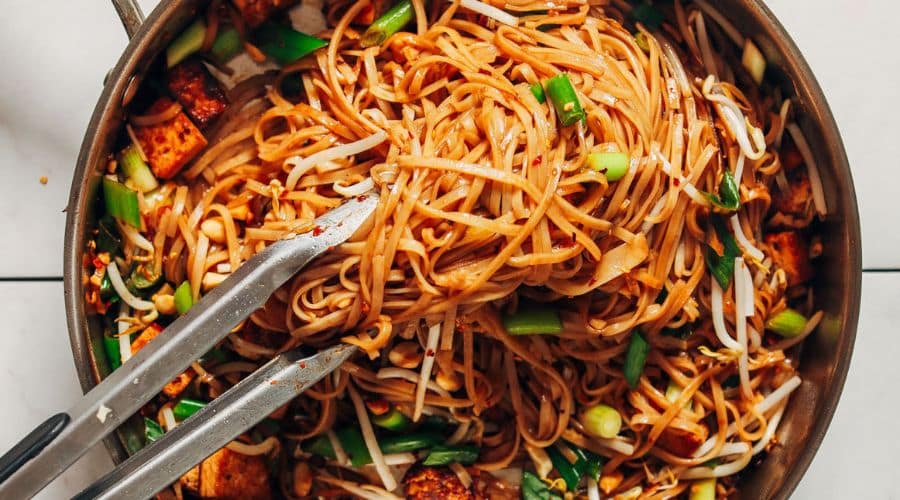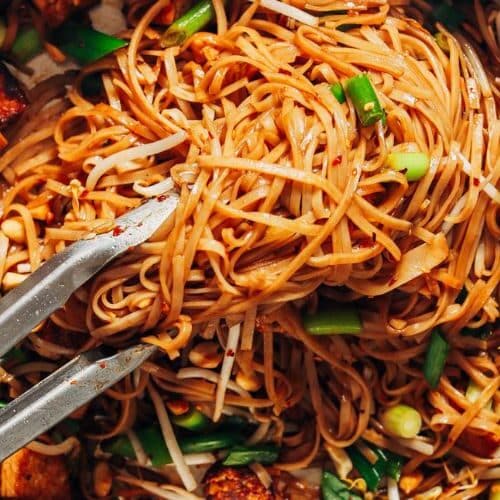All products are selected by our editorial team for quality. If you buy through our links, we may earn a small commission at no extra cost to you.
Pad Thai is one of Thailand’s most beloved dishes, known for its perfect balance of sweet, tangy, salty, and umami flavors.
Traditionally made with rice noodles, eggs, fish sauce, and shrimp, this stir-fried noodle dish has gained international fame for its irresistible taste and satisfying texture.
But what if you could enjoy the same bold flavors in a completely plant-based way?
This Vegan Pad Thai recipe keeps all the deliciousness of the original while using wholesome, cruelty-free ingredients.
Whether you’re a longtime vegan, trying to eat more plant-based meals, or simply looking for a lighter, healthier version of your favorite Thai dish, this recipe is for you!

What is Pad Thai?
Pad Thai is a famous street food dish that originated in Thailand.
It consists of stir-fried rice noodles tossed with a flavorful sauce made from tamarind, fish sauce, and palm sugar, typically served with eggs, shrimp, tofu, and crunchy peanuts.
How Does This Vegan Version Compare?
Instead of fish sauce and eggs, this Vegan Pad Thai relies on a rich, umami-packed sauce using tamarind paste, soy sauce, and maple syrup.
The protein comes from tofu or tempeh, while a variety of fresh vegetables add crunch and vibrant colors.
Topped with peanuts and fresh herbs, this dish delivers the same authentic flavors while being completely plant-based.
Why You’ll Love This Vegan Pad Thai
This Vegan Pad Thai isn’t just a great plant-based alternative—it’s a meal that stands on its own! Here’s why you’ll love it:
Quick & Easy to Make
With just a few simple steps, this dish comes together in under 30 minutes, making it perfect for weeknight dinners.
Bursting with Flavor
The combination of tangy tamarind, savory soy sauce, and a hint of sweetness creates the perfect balance of flavors.
Healthy & Nutritious
Packed with plant-based protein, fiber-rich veggies, and healthy fats, this dish is as nourishing as it is tasty.
Customizable
Swap in your favorite vegetables, adjust the spice level, or try different plant-based proteins to make it your own.
Key Ingredients for Vegan Pad Thai
Rice Noodles
The heart of any Pad Thai! Look for flat rice noodles that are soft yet chewy when cooked.
Plant-Based Protein
- Tofu – Firm or extra-firm tofu works best, giving a crispy texture when pan-fried.
- Tempeh – Adds a nutty flavor and extra protein.
- Edamame or Chickpeas – Great alternatives for variety.
Vegetables
- Carrots – Julienned or shredded for a slight crunch.
- Bell Peppers – Adds sweetness and color.
- Bean Sprouts – Essential for authentic Pad Thai texture.
- Green Onions – Brings mild oniony flavor.
Vegan Pad Thai Sauce
The magic behind this dish is the sauce! Here’s what you’ll need:
- Tamarind Paste – Gives Pad Thai its signature tangy taste.
- Soy Sauce or Tamari – Adds depth and umami.
- Maple Syrup or Coconut Sugar – For the perfect touch of sweetness.
- Lime Juice – Enhances the freshness.
- Garlic & Chili Flakes – Optional, for extra spice.
Garnishes
- Crushed Peanuts – Adds crunch and a nutty finish.
- Fresh Cilantro – Brings freshness and aroma.
- Lime Wedges – A final squeeze of lime makes all the difference.
How to Make Vegan Pad Thai (Step-by-Step Guide)

Step 1: Prepare the Ingredients
- Soak or cook the rice noodles according to package instructions. Drain and set aside.
- Press and dice the tofu into bite-sized cubes.
- Slice the vegetables and prepare the garnishes in advance for easy assembly.
Step 2: Make the Vegan Pad Thai Sauce
- In a small bowl, whisk together tamarind paste, soy sauce, maple syrup, lime juice, garlic, and chili flakes.
- Taste and adjust the balance of flavors—add more sweetness, acidity, or salt as needed.
Step 3: Cook the Tofu and Vegetables
- Heat a pan over medium-high heat and add a little oil.
- Sauté the tofu until golden brown on all sides. Remove and set aside.
- In the same pan, stir-fry the vegetables for a minute or two until slightly softened but still crisp.
Step 4: Combine Everything
- Add the cooked noodles to the pan along with the tofu.
- Pour in the Pad Thai sauce, tossing everything together until well coated.
- Let it cook for 1-2 minutes, allowing the flavors to absorb.
Step 5: Garnish and Serve
- Plate the Pad Thai and top with crushed peanuts, fresh cilantro, and lime wedges.
- Serve immediately and enjoy your homemade Vegan Pad Thai!
Would you like any modifications or additional details?
Tips for the Best Vegan Pad Thai
To make sure your Vegan Pad Thai turns out perfect every time, keep these expert tips in mind:
Choose the Right Noodles
- Use flat rice noodles for the best texture. Avoid overcooking them—soak or cook according to package instructions and rinse with cold water to prevent sticking.
Balance the Sauce Flavors
- Pad Thai sauce is all about balance. Adjust the sweet (maple syrup), sour (tamarind), salty (soy sauce), and spicy (chili flakes) components to suit your taste.
Don’t Overcrowd the Pan
- Stir-fry ingredients in batches if needed. Overcrowding leads to steaming instead of frying, which can make the dish mushy.
Cook on High Heat for Authentic Flavor
- A quick stir-fry on medium-high to high heat helps develop deep flavors and prevents sogginess.
Don’t Skip the Garnishes
- Crushed peanuts, fresh cilantro, and lime wedges elevate the dish with crunch, freshness, and brightness.
Variations and Substitutions
One of the best things about Vegan Pad Thai is its customizability! Here are some ways to switch things up:
Gluten-Free Option
- Swap soy sauce for tamari or coconut aminos to make it completely gluten-free.
Nut-Free Version
- Replace peanuts with toasted sesame seeds or sunflower seeds for a nut-free alternative.
Soy-Free Alternative
- Instead of tofu, use mushrooms, jackfruit, or extra veggies like zucchini or cauliflower for a soy-free version.
Extra Veggies & Protein Options
- Add broccoli, snap peas, shredded cabbage, or bok choy for more variety.
- Swap tofu for chickpeas, seitan, or lentils to experiment with different protein sources.
Adjust the Spice Level
- If you love spice, add sriracha or chili garlic sauce to the Pad Thai sauce or as a topping.
- For a mild version, reduce or skip the chili flakes altogether.
What to Serve with Vegan Pad Thai
Vegan Pad Thai is a complete meal on its own, but pairing it with side dishes can create an even more satisfying dining experience. Here are some great accompaniments:
Fresh & Light Sides
- Thai Cucumber Salad – A refreshing, tangy salad with cucumbers, vinegar, and sesame seeds.
- Mango Salad – A sweet and spicy combination of ripe mango, lime, and chili.
Appetizers
- Spring Rolls with Peanut Sauce – Fresh or fried spring rolls with a creamy, nutty dip.
- Edamame with Sea Salt – A simple yet satisfying side packed with protein.
Drinks
- Thai Iced Tea – A creamy, slightly sweet tea that pairs well with the dish.
- Coconut Water – A light, refreshing beverage to complement the rich flavors of Pad Thai.
Would you like to add more serving ideas or variations?
Common Mistakes to Avoid
Even with a simple recipe like Vegan Pad Thai, small missteps can affect the final dish. Avoid these common mistakes for the best results:
Overcooking or Undercooking the Noodles
- Rice noodles cook quickly, and overcooking them can make them mushy. Soak them just until soft and rinse them with cold water to prevent sticking.
Skipping the Tamarind Paste
- Tamarind gives Pad Thai its signature tangy flavor. If you don’t have it, try fresh lime juice, but don’t leave out the sour element entirely.
Not Balancing the Sauce
- Taste and adjust the sauce before adding it to the noodles. If it’s too salty, add a bit more sweetness or acidity.
Cooking Everything at Once
- Cook the tofu first, then the vegetables, and then toss everything together at the end. Overloading the pan can lead to steaming instead of stir-frying.
Forgetting the Garnishes
- Peanuts, cilantro, and lime wedges make a huge difference in flavor and texture. Don’t skip them!
Conclusion
Vegan Pad Thai is a delicious, satisfying dish that proves you don’t need meat, eggs, or fish sauce to enjoy the bold flavors of this Thai classic.
With its balance of savory, sweet, tangy, and spicy flavors, it’s the perfect plant-based meal for any occasion.
By following these tips, avoiding common mistakes, and experimenting with different variations, you can create a Pad Thai that’s uniquely yours.
Try this recipe, adjust it to your taste, and enjoy a wholesome, restaurant-quality meal at home!
Have any questions or tried this recipe? Leave a comment below—I’d love to hear your thoughts!
Frequently Asked Questions
1. Can I make Vegan Pad Thai ahead of time?
Yes! You can prepare the sauce and chop the vegetables in advance.
However, for the best texture, stir-fry the noodles and tofu fresh before serving.
2. How do I store and reheat leftovers?
Store leftovers in an airtight container in the fridge for up to 3 days.
Reheat in a pan with a splash of water or oil to keep the noodles from drying out.
3. What can I use instead of tamarind paste?
If you don’t have tamarind paste, try using lime juice mixed with a bit of brown sugar or rice vinegar for a similar tangy flavor.
4. Can I make this without tofu?
Absolutely! You can replace tofu with chickpeas, tempeh, mushrooms, or extra vegetables for a tofu-free version.
5. Is this recipe spicy? Can I adjust the spice level?
This recipe is mildly spiced, but you can adjust the heat by adding more or less chili flakes, sriracha, or fresh Thai chilies based on your preference.
Would you like any additional details or modifications?

Vegan Pad Thai
Equipment
- 1 Large skillet or wok
- 1 Medium mixing bowl
- 1 Cutting board
- 1 Chef’s knife
- 1 Wooden spoon or tongs
- 1 Small whisk or fork
- 1 Measuring Cups & Spoons
Ingredients
For the Noodles & Stir-Fry:
- 6 oz Flat rice noodles
- 1 tbsp Neutral oil coconut, avocado, or vegetable
- ½ block Firm or extra-firm tofu pressed & cubed
- 1 cup Carrots julienned or shredded
- 1 cup Bell peppers thinly sliced
- 1 cup Bean sprouts
- 2 stalks Green onions chopped
For the Vegan Pad Thai Sauce:
- 2 tbsp Tamarind paste
- 2 tbsp Soy sauce or tamari for gluten-free
- 1 tbsp Maple syrup or coconut sugar
- 1 tbsp Lime juice
- 2 cloves Garlic minced
- ½ tsp Chili flakes adjust to taste
For Garnishing:
- ¼ cup Crushed peanuts
- ¼ cup Fresh cilantro chopped
- 1 Lime cut into wedges
Instructions
Step 1: Prepare the Ingredients
- Soak or cook the rice noodles according to package instructions, then rinse under cold water and set aside.
- Press and cut the tofu into cubes. Chop the vegetables and prepare the garnishes.
Step 2: Make the Vegan Pad Thai Sauce
- In a bowl, whisk together tamarind paste, soy sauce, maple syrup, lime juice, garlic, and chili flakes. Adjust the flavors as needed.
Step 3: Cook the Tofu and Vegetables
- Heat 1 tbsp of oil in a skillet or wok over medium heat. Add the tofu cubes and cook for 4-5 minutes, turning until golden brown. Remove and set aside.
- In the same pan, stir-fry the carrots and bell peppers for 2 minutes until slightly softened.
Step 4: Combine Everything
- Add the cooked noodles to the pan, followed by the tofu and Pad Thai sauce. Toss everything together for 2-3 minutes until evenly coated.
- Stir in the bean sprouts and green onions, then remove from heat.
Step 5: Garnish and Serve
- Plate the Pad Thai and top with crushed peanuts, fresh cilantro, and lime wedges.
- Serve immediately and enjoy!
Notes
- Gluten-Free Option: Use tamari or coconut aminos instead of soy sauce.
- Nut-Free Version: Replace peanuts with sesame seeds or sunflower seeds.
- Spice Level: Add more chili flakes or sriracha for extra heat.
- Storage & Reheating: Store leftovers in an airtight container in the fridge for up to 3 days. Reheat in a pan with a splash of water or oil to restore texture.

